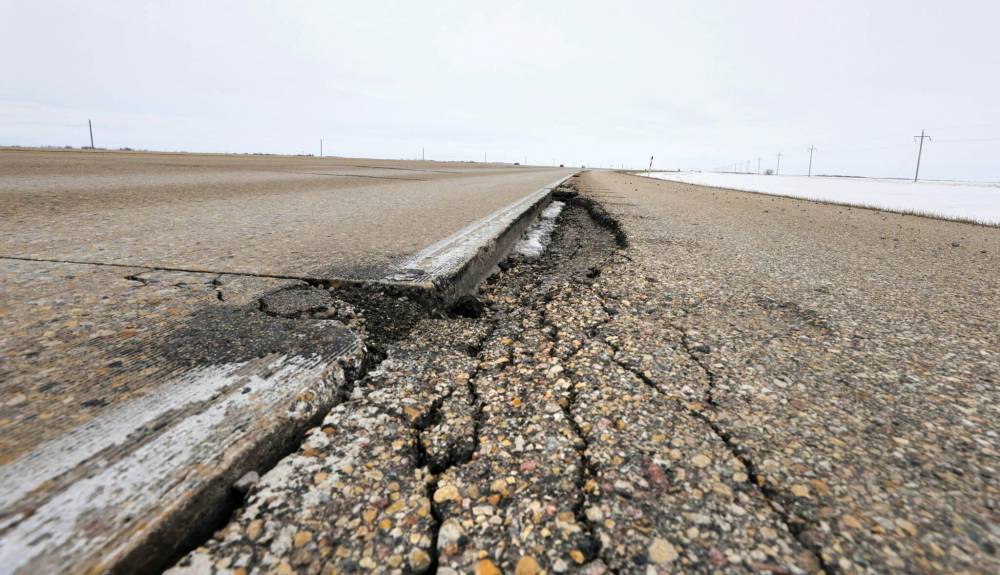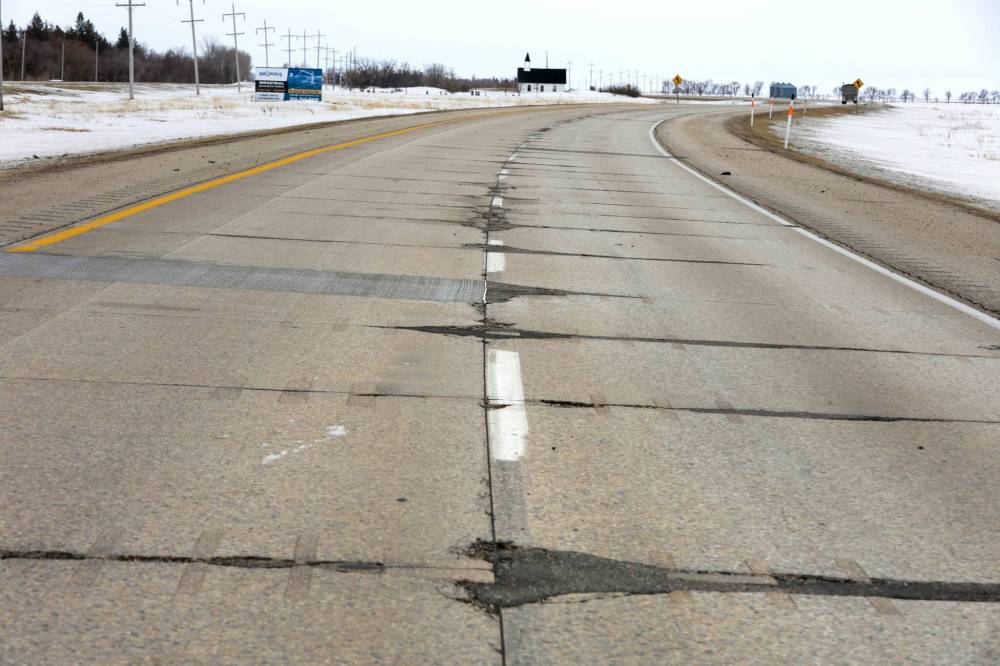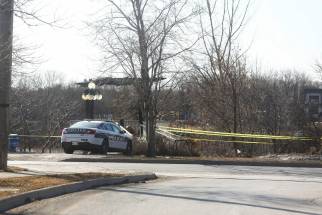Manitoba knows how to build highways; the trouble is maintaining them
Read this article for free:
or
Already have an account? Log in here »
To continue reading, please subscribe:
Monthly Digital Subscription
$0 for the first 4 weeks*
- Enjoy unlimited reading on winnipegfreepress.com
- Read the E-Edition, our digital replica newspaper
- Access News Break, our award-winning app
- Play interactive puzzles
*No charge for 4 weeks then price increases to the regular rate of $19.00 plus GST every four weeks. Offer available to new and qualified returning subscribers only. Cancel any time.
Monthly Digital Subscription
$4.75/week*
- Enjoy unlimited reading on winnipegfreepress.com
- Read the E-Edition, our digital replica newspaper
- Access News Break, our award-winning app
- Play interactive puzzles
*Billed as $19 plus GST every four weeks. Cancel any time.
To continue reading, please subscribe:
Add Free Press access to your Brandon Sun subscription for only an additional
$1 for the first 4 weeks*
*Your next subscription payment will increase by $1.00 and you will be charged $16.99 plus GST for four weeks. After four weeks, your payment will increase to $23.99 plus GST every four weeks.
Read unlimited articles for free today:
or
Already have an account? Log in here »
Hey there, time traveller!
This article was published 17/04/2023 (970 days ago), so information in it may no longer be current.
In early April, Transportation Minister Doyle Piwniuk announced the government will spend $61 million on a stretch of Highway 75 from Ste. Agathe to Morris featuring a rather lofty goal.
“We want to rebuild it so it’s an interstate-like design,” the minister said.
That term — “interstate design,” and its close cousin, “interstate standard” — summons well-known images of highways south of the Canada-United States border, those smooth and pristine ribbons of concrete that put Manitoba roadways to shame.
There’s just one problem.
There really is no such thing as interstate design or standard. I found that out a few years ago during an in-depth feature project looking at highway conditions on both sides of the border.
The results of my research were definitive: Manitoba builds highways in the exact same way, using the exact same materials, in the exact same proportion, as North Dakota.
RUTH BONNEVILLE / WINNIPEG FREE PRESS FILES In early April, Transportation Minister Doyle Piwniuk announced the government will spend $61 million on a stretch of Highway 75 from Ste. Agathe to Morris featuring a rather lofty goal.
Highways are constructed from soil, aggregate and concrete reinforced by dowels or rebar, or both. Contrary to popular wisdom, our American cousins do not use any space-age materials, or apply advanced construction techniques or employ radical variations in design.
What is different is the sheer amount of money North Dakota invests in rebuilding, restoring and repairing its roads.
Flush with cash from the Highway Trust Fund — a program that channels federal gas taxes into annual funding for the Interstate highway system — North Dakota spends hundreds of millions of dollars more per year on its major highways than we do in Manitoba. And not just on rebuilding new sections of roadway.
Back in 2015, the base year for the analysis in my highways series, North Dakota spent more than CDN$1 billion on its highways system. That same year, Manitoba spent about $600 million, largely fuelled by the NDP government’s controversial decision to raise the provincial sales tax by one point to fund infrastructure.
Now, consider the fact that North Dakota has 500,000 fewer residents and 8,000 fewer kilometres in combined roads and highways.
It’s not fair to put the entire blame on Manitoba for this funding shortfall. In the U.S., the federal government is a huge financial supporter of the interstate system; in Canada, federal infrastructure dollars are focused largely on municipal projects, not major highways.
It’s not fair to put the entire blame on Manitoba for this funding shortfall. In the U.S., the federal government is a huge financial supporter of the interstate system; in Canada, federal infrastructure dollars are focused largely on municipal projects, not major highways.
However, the provinces do not help their cause when they spend so little on repairs and maintenance.
It wasn’t mentioned in the news release, but there is little doubt this section of the highway has been neglected, in terms of maintenance. We know that because highways that are properly maintained last much, much longer.
A brand-new concrete highway can, with the proper attention to repairing and filling cracks and resurfacing the concrete with asphalt later on, last up to 50 years. According to the most recent Highway 75 funding announcement, the sections scheduled for reconstruction this summer are between 32 and 35 years old.
Although the frequency of overland flooding and other environmental factors should be considered, this section of road has failed decades sooner than the normal life cycle of a half-century.
It’s important to consider the financial implications of letting a concrete highway fall into disrepair decades earlier than necessary. Again, using the numbers from the most recent announcement, Manitoba will spend $61 million to replace 27 kilometres of highway from Ste. Agathe to Morris. That works out to $2.2 million per kilometre.
RUTH BONNEVILLE / WINNIPEG FREE PRESS FILES Under the leadership of Premier Heather Stefanson, the total amount of capital investment in highways has increased from $375 million to $500 million in the current budget year.
But there’s a catch: that’s 27 kilometres of southbound highway only. The northbound lanes will, no doubt, be addressed in the future, but taken together, it costs $4.4 million to replace one kilometre of four-lane highway.
With costs like that, you would think that government would be going to extraordinary lengths to protect that investment. Unfortunately, that is not the case.
Road construction is a capital expense, meaning the government borrows the money to build or rebuild highways and pays it off over many years. Road maintenance, however, is an annual operating expense.
Under the leadership of Premier Heather Stefanson, the total amount of capital investment in highways has increased from $375 million to $500 million in the current budget year. This is an attempt to catch up for the deep cuts to capital infrastructure spending during the years Brian Pallister was in charge.
As one 27-kilometre section of Highway 75 has shown us, increased investment in building a new highway without a big bump in maintenance and repair is not just short-term thinking. It’s unconscionably wasteful.
However, over the next five years, funding for maintenance and repairs will be frozen at $137 million. Not an insignificant amount, but when you start with a figure that is already insufficient to maintain our inventory of highways, a failure to increase that budget line means many more roads will fall into disrepair decades before they might otherwise have.
As one 27-kilometre section of Highway 75 has shown us, increased investment in building a new highway without a big bump in maintenance and repair is not just short-term thinking. It’s unconscionably wasteful.
When the provincial election campaign starts later this year, voters will, no doubt, be tempted by candidates from various political parties pledging to build billions of dollars of new infrastructure. Just for fun, voters might ask those politicians a followup question.
Have you figured out how to make it last?
dan.lett@winnipegfreepress.com

Dan Lett is a columnist for the Free Press, providing opinion and commentary on politics in Winnipeg and beyond. Born and raised in Toronto, Dan joined the Free Press in 1986. Read more about Dan.
Dan’s columns are built on facts and reactions, but offer his personal views through arguments and analysis. The Free Press’ editing team reviews Dan’s columns before they are posted online or published in print — part of the our tradition, since 1872, of producing reliable independent journalism. Read more about Free Press’s history and mandate, and learn how our newsroom operates.
Our newsroom depends on a growing audience of readers to power our journalism. If you are not a paid reader, please consider becoming a subscriber.
Our newsroom depends on its audience of readers to power our journalism. Thank you for your support.










